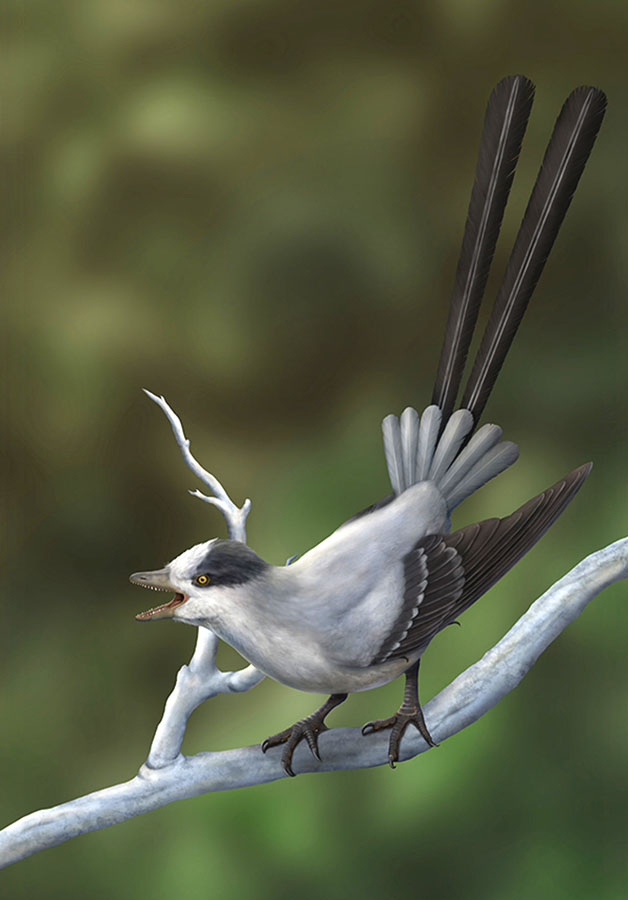New Bird Species from Cretaceous Period Had Long Pintail

Paleontologists in China have identified a new species of pengornithid enantiornithine bird with a pair of elaborate tail feathers.
Enantiornithes are the most successful group of Mesozoic birds, arguably representing the first global avian radiation.
They are known exclusively from the Cretaceous period, predominantly from fossils discovered in Asia, and commonly resolved as the sister to Ornithuromorpha, the group within which all living birds are nested.
The new species is a member of the family Pengornithidae, one of the earliest diverging enantiornithine groups.
Named Yuanchuavis kompsosoura, it lived approximately 120 million years ago in what is now northeastern China and belonged to the famous Jehol Biota.
It was a small bird, about the size of a bluejay, but its tail was more than 150% the length of its body.
“Yuanchuavis kompsosoura had a fan of short feathers at the base and then two extremely long plumes,” said Dr. Jingmai O’Connor, a paleontologist at the Field Museum.
“The long feathers were dominated by the central spine, called the rachis, and then plumed at the end.”
“The combination of a short tail fan with two long feathers is called a pintail, we see it in some modern birds like sunbirds and quetzals.”
“We’ve never seen this combination of different kinds of tail feathers before in a fossil bird.”

Yuanchuavis kompsosoura is the first documented occurrence of a pintail in Enantiornithes.
“Notably, the morphology preserved in Yuanchuavis kompsosoura essentially represents a combination of the two tail morphologies previously recognized in other enantiornithines which are most closely related to Yuanchuavis kompsosoura,” said Dr. Wang Min, a researcher at the Chinese Academy of Sciences.
“Its tail fan is aerodynamically functional, whereas the elongated central paired plumes are used for display, which together reflect the interplay between natural selection and sexual selection.”
In other words, Yuanchuavis kompsosoura would have been able to fly well, but its long tail feathers that might have helped it find mates didn’t make flying any easier — its fancy tail was literally a drag.
This balance between natural and sexual selection has interested scientists since the time of Darwin: if evolution produces organisms that are better able to meet the pressures of the world around them, then why would an animal develop traits that make it worse at flying or more noticeable to its predators?
“Scientists call a trait like a big fancy tail an ‘honest signal,’ because it is detrimental, so if an animal with it is able to survive with that handicap, that’s a sign that it’s really fit,” Dr. O’Connor said.
“A female bird would look at a male with goofily burdensome tail feathers and think, ‘Dang, if he’s able to survive even with such a ridiculous tail, he must have really good genes’.”
“It is well known that sexual selection plays a central role in speciation and recognition in modern birds, attesting to the enormous extravagant feathers, ornaments, vocals, and dances,” Dr. Wang said.
“However, it is notoriously difficult to tell if a given fossilized structure is shaped by sexual selection, considering the imperfect nature of the fossil record.”
“Therefore, the well-preserved tail feathers in this new fossil bird provide great new information about how sexual selection has shaped the avian tail from their earliest stage.”
“The complexity we see in Yuanchuavis kompsosoura’s feathers is related to one of the reasons we hypothesize why living birds are so incredibly diverse, because they can separate themselves into different species just by differences in plumage and differences in song,” Dr. O’Connor said.
“It’s amazing that Yuanchuavis kompsosoura lets us hypothesize that that kind of plumage complexity may already have been present in the Early Cretaceous.”
The study was published in the journal Current Biology.
_____
Min Wang et al. An Early Cretaceous enantiornithine bird with a pintail. Current Biology, published online August 16, 2021; doi: 10.1016/j.cub.2021.08.044
Source: www.sci-news.com/








